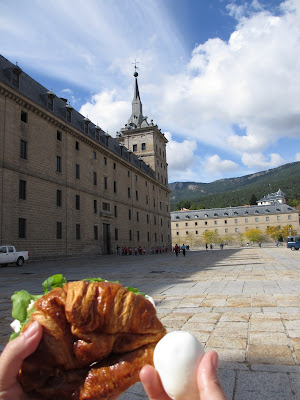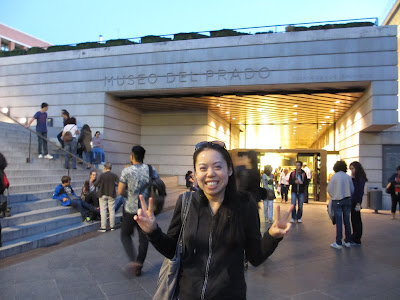10/9/2015
We went to El Escorial today, which is a monastery in the
mountains about an hour outside Madrid. It also serves as a royal palace, as
well as the final resting place for most of Spain’s monarchs. It’s a really
popular day trip; over a million people visit each year, according to the
audioguide.
You have to buy the Cercanias Renfe train tickets at the grey ticket machines; the purple Renfe ticket machines doesn’t sell these because Renfe proper is for long distance trains and Cercanias Renfe is the commuter train servicing nearby Madrid. We found this out after much fiddling around with the machines yesterday, so we knew how to buy them today. Another thing with commuter trains: you can’t pre-book tickets. It’s like buying metro tickets for the train.
The train to El Escorial doesn’t come along that often, partly because most people who go are part of a tour and therefore are bused there. Indeed, it was like being in National Palace of Sintra all over again. We felt like we were always being herded into the next room because there were so many tour groups and we didn’t want to get stuck in the same room with them. It’s very hard to hear the audioguide (which we paid a steep 4 euros each for) when there’s 50 people trampling around in the same tiny room.
You are not allowed to take pictures inside the complex. When buying the admission tickets, the cashier held onto my credit card for a while without swiping it before finally announcing that she can’t (won’t) take my credit card. Thank God I had cash on me! These experiences damped my mood to the monastery, but it’s so steeped in history, I soon forgot these slights.
One of the first
rooms we saw was the king’s bedchamber, where Philip II died in his bed of old
age. He had sundials installed in his quarters, as well as an oil
lamp-cum-clock (a relatively new and novel invention for his time), and had his
bed tilted so he could see out the interior window of his bedroom to the basilica
down below. His body was weak, but he still wanted to attend mass in some form.
We saw the mausoleum where all the royals are buried, from
Charles V to Philip II (Mary Tudor’s husband, and who the Philippines Islands
is named after), to the wives who bore future kings. Don’t know what happened
to the wives who didn’t beget sons. It’s a vast room underground where all the
stairs, walls, and ceilings are made of marble in shades of red, white, and
green. Now that’s lavish.
When you return upstairs, immediately adjacent are crypts for lesser known royals. There’s even a knave for the king’s natural sons (aka bastards). Some crypts have a lot of people laid at rest, others are devoted to only one person, so we were wondering if somehow those people are more important? I believe one who had the whole room to herself was Infanta Isabella Clara Eugenia, Philip II’s beloved daughter by Elizabeth Valois. She helped her father with court affairs and nursed him through his final years when he was plagued by gout and had to be toted around in a wheelchair of sorts (also on display at El Escorial). This unique folding chair was made in China especially for the king. It allowed him to recline, to elevate his feet, and could hang a canopy over it should he become too hot.
El Escorial was built on the orders of King Philip II as an ode to St. Lawrence and to celebrate his victory against Henry II, King of France. It is said that St. Lawrence refused to give his parish’s money over to greedy bishops, even on threat of death. He declared the poor as the ones to be venerated and worshipped, and therefore, the money should go toward them. The bishops had him tied up and roasted. Even as he was roasted on the spit, St. Lawrence said something to the tune of: “You should turn me over; I’m well-roasted on this side already.” as his final defiance to these corrupt officials.
Most English remember Philip II as the calculating,
power-hungry husband of Mary Tudor, who, upon her death, promptly proposed to
her half-sister, Queen Elizabeth I. He is also the one who, a few decades
later, sent his famed Spanish Armada across the English Channel to war against
Elizabeth I’s navy. Spain was supposed to win; their navy was far superior to
England’s motley crew. But Spain lost, and their navy was decimated, to which
they’ve never recovered. England’s navy quickly rose in esteem and prominence,
and soon became renowned as the most powerful navy in the world.
In Spain, however, Philip II is regarded as a national hero.
Under his guidance, Spain rose to the peak of its power. In fact, his rule is
referred to as the Spanish Golden Age and under his rule, the phrase “the
empire on which the sun never sets” was coined. He inherited a large portion of
Europe (google how many titles he has!), and used to say “The world is not
enough.” The gold discovered from his America territories funded a Renaissance
of sorts, including the building of El Escorial. He was a deeply religious Catholic,
to the point where his policies were all for defeating Protestantism (part of
the reason why he went to war against the Protestant Elizabeth I).
The church in El Escorial is breathtaking—the centerpiece
triptych alone is 26 m high! It’s gilded and marbled everywhere. Phillip II had
the church built rather uniquely in that there are arches along the walls,
where the common people were designated to be when they attend mass. Because Philipp
II didn’t want to attend mass with the common folks, he deliberately placed
them out of his way.
The art at El Escorial is considered one of the best
collections in Europe, according to the audioguide. I don’t feel like the
audioguide added much to enhance the experience, as the placards in each room
pretty much repeats what the audioguide says. Half the rooms were not open to
visitors today, which sucked because those were the halls of tapestries, etc.,
which is more in tune to the stuff I like looking at.
The final stop on the audioguide tour is the library, which
houses over 4000 volumes of historical significance. Some of these works are
over six hundred years old!
Because the audioguide wasn’t as informative as I’d hoped,
we ended up finishing a whole lot faster than we’d originally planned. We’d
planned to be there for the entire day! But the whole visit took less than 3
hours.
Angel made croissant sandwiches for our trip and they tasted
delicious! We’ve never had chorizo slices before, but they’re damn good!
Mom made soft hard-boiled egg, which were yummy too. Gotta use off those 20 eggs we bought yesterday!
On the hike back down the mountain, there's houses lining the wide dirt-paved pedestrian-only avenue. Most garages are just blank slates, but someone painted this on one garage:
 |
| Le Petit Prince! |
As we ate, we walked back toward the train station to hop onto
the next Cercanias home. Since El Escorial’s the end stop, the train was empty.
By the time we reached the outskirts of Madrid, it was crammed full. I’d
originally planned for dinner at La Cabrera restaurant, but there was still
much to do, so we decided to eat in tonight, feasting on Carrefour goodies.
We walked to the Plaza de Cibeles, which is Madrid’s City
Hall and an iconic representation of the city:
Then we went hunting for a Casa so Angel could fawn over
more home goods. She’d already mapped out how to get there, so it wasn’t that
bad a walk. Though I will say that for people who complain Lisbon is too hilly,
you should come to Madrid! It’s a whole lot worse than Lisbon. Every single
street goes up or down; there’s really no respite! Finally, we reach the top of a hill:
 |
| old-looking mailboxes |
We climbed all the way up to the posh neighborhood where Casa (and a whole heck of a lot of American name brands) are housed, only to turn around pretty fast and go back down again because the Prado Museum (Spain’s most famous art museum) is free every day from 6-8pm. By the time we got in line, it was 5:55pm.
TripAdvisor had advised that you should get there early because of the crazy long lines...but being me, I didn’t believe them. Totally should’ve. When we got there, the line was snaking all the way around the back of the building!
Because Madrid’s so spread out, you usually don’t get the sense that there’s a whole lot of tourists here. But show up at the Prado at 6pm, and all the tourists have turned out full force. We waited ½ hour to get inside the museum, but it’s so vast, an hour and a half doesn’t even begin to do the museum justice.
Unfortunately, I don’t think I’ll have the time to come back here and explore at leisure, so I had to dart around, dragging my parents and Angel with me as I hunted down the pieces I wanted to look at. I saw the Goyas, the El Grecos, Ribera, Murillo, Fortuny, along with the famous artists from other countries like Memling and Titian.
I finally found the Velazquez painting I wanted to see when
the usher kinda just blocked me off from inspecting it closer. It was 7:50pm
and the ushers were starting to boot people down the stairs. I’m not kidding.
Most ushers in other museums will gently remind you that it’s near closing time, but these
ushers were like Nazis, pushing everyone out. It wasn’t even 8
yet! They even blocked off the bathrooms so you couldn’t go in (what if I’d
been holding in my pee, trying to see every last painting there is??? What then, I ask you?).
Across the Prado is a tourist shop that sells bullfighting memorabilia and these dolls that remind me of Angel's Dolly Madison project back in elementary school:
Angel had hand-sewn the doll and painted a face on it that scared the bejesus outta me for the next decade. It didn't help that the doll sat on top of a wardrobe, so every time I entered the room, I felt like it was looking down at me and tracking my every move. Thank God Mom threw it away.
We walked Dad back to the hotel, which is only ten minutes
away from the Prado. After we dropped him off, we went to Carrefour Market to
stock up for the next few days. Angel found this Spanish cookie she really
liked with the texture halfway between a truffle filling and shortbread. It’s
called Mantecado, and it’s kneaded in lard. I guessed the Canela flavor was
condensed milk, but after getting home and checking google, apparently it’s cinnamon.
Hey, I didn’t take Spanish in high school!
Carrefour has a hot deli section that sells pig knuckle. So of course, Mom had to get it.
This cheese is friggin delicious!
Frozen croquettes that we baked off:

























No comments:
Post a Comment